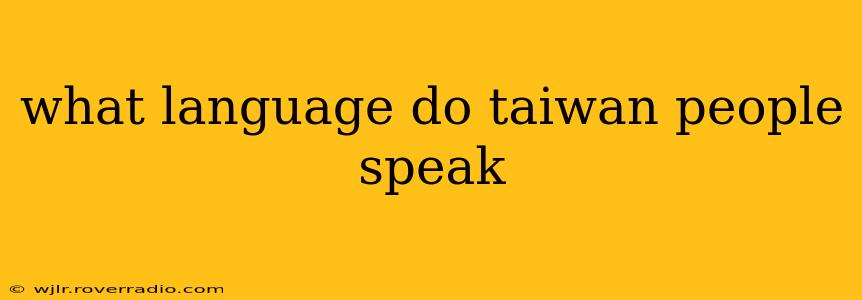Taiwan boasts a rich and diverse linguistic landscape, far more complex than a simple single answer. While Mandarin Chinese is the official language and widely spoken, the reality is far more nuanced, reflecting the island's unique history and cultural tapestry. This article delves into the languages spoken in Taiwan, addressing common questions and misconceptions.
What is the official language of Taiwan?
The official language of Taiwan is Mandarin Chinese, specifically Standard Mandarin based on the Beijing dialect. This is the language used in government, education, and most media. However, it's crucial to understand that this doesn't represent the entirety of the linguistic experience in Taiwan.
What other languages are spoken in Taiwan?
Beyond Mandarin, Taiwan's linguistic diversity is striking. Several significant languages are spoken, each with its own history and cultural significance:
-
Min Nan (Hokkien): This is arguably the most widely spoken language in Taiwan, particularly in southern and central regions. It's a Southern Min Chinese dialect with its own distinct vocabulary, grammar, and pronunciation, significantly different from Mandarin. Many Taiwanese identify strongly with their Min Nan heritage.
-
Hakka: Another significant Chinese dialect group spoken primarily in central and northern Taiwan, Hakka boasts its own unique features and cultural identity. It’s less widely spoken than Min Nan but remains a vital part of Taiwan's linguistic tapestry.
-
Formosan Languages (Austronesian): These indigenous languages represent the original inhabitants of Taiwan. There are currently 16 recognized Formosan languages, each with its distinct vocabulary, grammar, and cultural context. Sadly, many are endangered, facing the challenge of competing with dominant languages like Mandarin. Efforts are underway to preserve and revitalize these invaluable linguistic treasures.
-
English: English serves as a common second language, particularly in urban areas and among younger generations. Its usage is increasing due to globalization and the island’s strong ties with international commerce and education.
Are Taiwanese people fluent in Mandarin?
While Mandarin is the official language and taught extensively in schools, fluency levels vary across the population. Many older generations might be more fluent in Min Nan or Hakka, while younger generations are generally more proficient in Mandarin, especially in urban areas. A significant portion of the population is bilingual or even multilingual, speaking Mandarin alongside other languages such as Min Nan, Hakka, or English.
How many languages are spoken in Taiwan?
There isn't a single definitive answer to this question, as the categorization of dialects versus languages can be debated. However, considering Mandarin, Min Nan, Hakka, and the numerous Formosan languages, it's safe to say that a multitude of languages are spoken in Taiwan, representing a rich and complex linguistic landscape.
Why is there such a linguistic diversity in Taiwan?
Taiwan's linguistic diversity stems from its unique history and immigration patterns. The island’s indigenous population initially spoke various Formosan languages. Subsequent waves of immigration from mainland China brought Min Nan and Hakka speakers, creating a blend of cultures and languages. The promotion of Mandarin as the official language in recent decades has further shaped the linguistic landscape.
What are the efforts to preserve indigenous languages in Taiwan?
Taiwan's government and various organizations are actively involved in preserving and promoting its endangered indigenous languages. These efforts include language immersion programs, language revitalization initiatives, and the development of educational materials in indigenous languages. However, significant challenges remain in ensuring the long-term survival of these vital linguistic heritages.
In conclusion, understanding the languages spoken in Taiwan requires moving beyond simplistic answers. It's a vibrant tapestry woven from Mandarin, Min Nan, Hakka, Formosan languages, and English, reflecting the island's fascinating history and cultural richness. The ongoing efforts to preserve the indigenous languages are crucial in maintaining this linguistic diversity for future generations.
